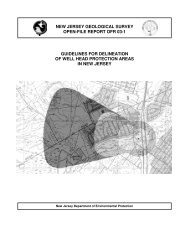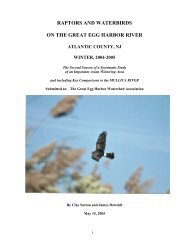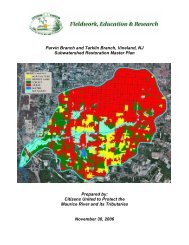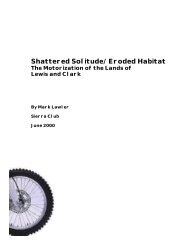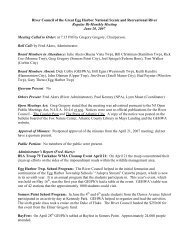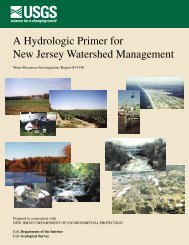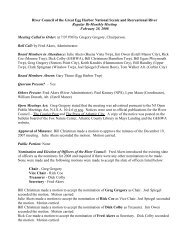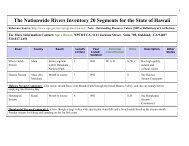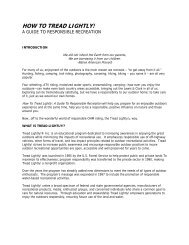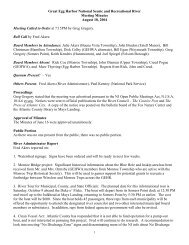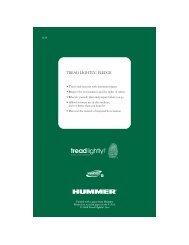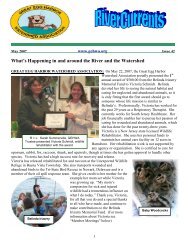Impacts of off-road vehicles on nitrogen cycles in biological soil crusts
Impacts of off-road vehicles on nitrogen cycles in biological soil crusts
Impacts of off-road vehicles on nitrogen cycles in biological soil crusts
Create successful ePaper yourself
Turn your PDF publications into a flip-book with our unique Google optimized e-Paper software.
Journal <str<strong>on</strong>g>of</str<strong>on</strong>g> Arid Envir<strong>on</strong>ments (2002) 52: 155–165<br />
doi:10.1006/jare.2002.0991, available <strong>on</strong>l<strong>in</strong>e at http://www.idealibrary.com <strong>on</strong><br />
<str<strong>on</strong>g>Impacts</str<strong>on</strong>g> <str<strong>on</strong>g>of</str<strong>on</strong>g> <str<strong>on</strong>g>of</str<strong>on</strong>g>f-<str<strong>on</strong>g>road</str<strong>on</strong>g> <str<strong>on</strong>g>vehicles</str<strong>on</strong>g> <strong>on</strong> <strong>nitrogen</strong> <strong>cycles</strong> <strong>in</strong><br />
<strong>biological</strong> <strong>soil</strong> <strong>crusts</strong>: resistance <strong>in</strong> different U.S.<br />
deserts<br />
Jayne Belnap<br />
U.S. Geological Survey, Forest and Rangeland Ecosystem Science Center,<br />
Cany<strong>on</strong>lands Field Stati<strong>on</strong>, 2290 S. West Resource Blvd., Moab, UT 84532,<br />
U.S.A.<br />
(Received 8 October 2001, accepted 17 January 2002)<br />
Biological <strong>soil</strong> <strong>crusts</strong> are an important comp<strong>on</strong>ent <str<strong>on</strong>g>of</str<strong>on</strong>g> desert ecosystems, as<br />
they <strong>in</strong>fluence <strong>soil</strong> stability and fertility. This study exam<strong>in</strong>ed and compared<br />
the short-term vehicular impacts <strong>on</strong> lichen cover and <strong>nitrogen</strong>ase activity<br />
(NA) <str<strong>on</strong>g>of</str<strong>on</strong>g> <strong>biological</strong> <strong>soil</strong> <strong>crusts</strong>. Experimental disturbance was applied to<br />
different types <str<strong>on</strong>g>of</str<strong>on</strong>g> <strong>soil</strong> <strong>in</strong> regi<strong>on</strong>s throughout the western U.S. (Great Bas<strong>in</strong>,<br />
Colorado Plateau, S<strong>on</strong>oran, Chihuahuan, and Mojave deserts). Results show<br />
that pre-disturbance cover <str<strong>on</strong>g>of</str<strong>on</strong>g> <strong>soil</strong> lichens is significantly correlated with the<br />
silt c<strong>on</strong>tent <str<strong>on</strong>g>of</str<strong>on</strong>g> <strong>soil</strong>s, and negatively correlated with sand and clay. While<br />
disturbance appeared to reduce NA at all sites, differences were statistically<br />
significant at <strong>on</strong>ly 12 <str<strong>on</strong>g>of</str<strong>on</strong>g> the 26 sites. Cool desert sites showed a greater<br />
decl<strong>in</strong>e than hot desert sites, which may <strong>in</strong>dicate n<strong>on</strong>-heterocystic<br />
cyanobacterial species are more susceptible to disturbance than n<strong>on</strong>heterocystic<br />
species. Sandy <strong>soil</strong>s showed greater reducti<strong>on</strong> <str<strong>on</strong>g>of</str<strong>on</strong>g> NA as sand<br />
c<strong>on</strong>tent <strong>in</strong>creased, while f<strong>in</strong>e-textured <strong>soil</strong>s showed a greater decl<strong>in</strong>e as sand<br />
c<strong>on</strong>tent <strong>in</strong>creased. At all sites, higher NA before the disturbance resulted <strong>in</strong><br />
less impact to NA post-disturbance. These results may be useful <strong>in</strong> predict<strong>in</strong>g<br />
the impacts <str<strong>on</strong>g>of</str<strong>on</strong>g> <str<strong>on</strong>g>of</str<strong>on</strong>g>f-<str<strong>on</strong>g>road</str<strong>on</strong>g> <str<strong>on</strong>g>vehicles</str<strong>on</strong>g> <strong>in</strong> different regi<strong>on</strong>s and different <strong>soil</strong>s.<br />
# 2002 Published by Elsevier Science Ltd.<br />
Keywords: <strong>soil</strong> surface disturbance; microbiotic <strong>soil</strong> crust; arid land;<br />
<strong>nitrogen</strong> <strong>cycles</strong>; <strong>biological</strong> <strong>soil</strong> crust<br />
Introducti<strong>on</strong><br />
Thirty per cent <str<strong>on</strong>g>of</str<strong>on</strong>g> the United States c<strong>on</strong>sists <str<strong>on</strong>g>of</str<strong>on</strong>g> semi-arid or arid landscapes (UNEP,<br />
1992). Human use has <strong>in</strong>creased exp<strong>on</strong>entially <strong>in</strong> most arid and semi-arid lands <str<strong>on</strong>g>of</str<strong>on</strong>g> the<br />
United States s<strong>in</strong>ce the late 1800s. Historically, most <str<strong>on</strong>g>of</str<strong>on</strong>g> this use has been livestock<br />
graz<strong>in</strong>g <strong>in</strong> areas where water was accessible; more recently, substantial <strong>in</strong>creases <strong>in</strong> <str<strong>on</strong>g>of</str<strong>on</strong>g>f<str<strong>on</strong>g>road</str<strong>on</strong>g><br />
vehicle and hik<strong>in</strong>g activity have greatly expanded direct human use both spatially<br />
and temporally. Although these uses do not directly remove surface material, they still<br />
can have pr<str<strong>on</strong>g>of</str<strong>on</strong>g>ound impacts <strong>on</strong> <strong>soil</strong> resources and nutrient <strong>cycles</strong>. As recovery times <strong>in</strong><br />
E-mail: jayne_belnap@usgs.gov<br />
0140-1963/02/020155 + 11 $35.00/0 # 2002 Published by Elsevier Science Ltd.
156 J. BELNAP<br />
these ecosystems can be extremely slow, effective management <str<strong>on</strong>g>of</str<strong>on</strong>g> this vast resource<br />
generally means preserv<strong>in</strong>g, to the greatest extent feasible, exist<strong>in</strong>g ecosystem<br />
structure and functi<strong>on</strong>.<br />
Recent ecological discussi<strong>on</strong> has addressed the hypothesis that natural disturbance<br />
is a major factor <strong>in</strong> the structur<strong>in</strong>g <str<strong>on</strong>g>of</str<strong>on</strong>g> communities, or <strong>in</strong> the words <str<strong>on</strong>g>of</str<strong>on</strong>g> Reich (1994),<br />
‘the normal state <str<strong>on</strong>g>of</str<strong>on</strong>g> communities and ecosystems is to be recover<strong>in</strong>g from the<br />
last disturbance.’ Ecosystems are likely to vary <strong>in</strong> both their resistance and resilience to<br />
disturbance. Deserts are generally c<strong>on</strong>sidered to have both low resistance<br />
and resilience to disturbance (Mack & Thomps<strong>on</strong>, 1982). However, it is expected<br />
that resistance and resilience to disturbance will vary am<strong>on</strong>g deserts as am<strong>on</strong>g<br />
ecosystems <strong>in</strong> general. There are many variables that may c<strong>on</strong>trol an ecosystem’s<br />
resp<strong>on</strong>se to disturbance, am<strong>on</strong>g them be<strong>in</strong>g the <strong>soil</strong>s, flora and fauna, climate, and the<br />
type and levels <str<strong>on</strong>g>of</str<strong>on</strong>g> disturbance that have been present <strong>in</strong> these systems over<br />
evoluti<strong>on</strong>ary time. Compar<strong>in</strong>g the resp<strong>on</strong>se <str<strong>on</strong>g>of</str<strong>on</strong>g> different desert systems may provide<br />
us with the ability to predict what areas will be less able to withstand anthropogenic<br />
activity.<br />
Biological <strong>soil</strong> <strong>crusts</strong> play an <strong>in</strong>tegral part <strong>in</strong> the functi<strong>on</strong><strong>in</strong>g <str<strong>on</strong>g>of</str<strong>on</strong>g> desert ecosystems<br />
(see Belnap & Lange, 2001, for review). They are <str<strong>on</strong>g>of</str<strong>on</strong>g>ten the dom<strong>in</strong>ant source <str<strong>on</strong>g>of</str<strong>on</strong>g><br />
<strong>nitrogen</strong> (N) for these ecosystems, therefore we chose to look at the resp<strong>on</strong>se <str<strong>on</strong>g>of</str<strong>on</strong>g><br />
<strong>nitrogen</strong> fixati<strong>on</strong> <strong>in</strong> <strong>crusts</strong> as an <strong>in</strong>dicator <str<strong>on</strong>g>of</str<strong>on</strong>g> resistance to disturbance. Nitrogen <strong>in</strong><br />
deserts is <str<strong>on</strong>g>of</str<strong>on</strong>g> c<strong>on</strong>cern because N, after water, is generally c<strong>on</strong>sidered the element most<br />
limit<strong>in</strong>g primary productivity <strong>in</strong> semi-arid and arid ecosystems (Romney et al., 1978).<br />
Input rates <str<strong>on</strong>g>of</str<strong>on</strong>g> N from atmospheric and parent material sources are extremely low <strong>in</strong><br />
arid regi<strong>on</strong>s, and these systems can be dependent <strong>on</strong> N fixed by <strong>biological</strong> <strong>soil</strong> <strong>crusts</strong><br />
(Evans & Ehler<strong>in</strong>ger, 1993). Previous studies show that <strong>soil</strong> surface disturbance can<br />
greatly reduce or elim<strong>in</strong>ate N fixati<strong>on</strong> <strong>in</strong> <strong>biological</strong> <strong>soil</strong> <strong>crusts</strong> (Belnap et al., 1994;<br />
Belnap, 1995, 1996; Evans & Belnap, 1999). This lack <str<strong>on</strong>g>of</str<strong>on</strong>g> <strong>in</strong>put from the <strong>biological</strong><br />
<strong>soil</strong> <strong>crusts</strong> is reflected <strong>in</strong> plant tissue N levels (Harper & Pendlet<strong>on</strong>, 1993; Belnap &<br />
Harper, 1995). S<strong>in</strong>ce N loss is a c<strong>on</strong>t<strong>in</strong>uous process, understand<strong>in</strong>g factors that<br />
decrease N availability is <str<strong>on</strong>g>of</str<strong>on</strong>g> critical importance to ma<strong>in</strong>ta<strong>in</strong><strong>in</strong>g the susta<strong>in</strong>ability <str<strong>on</strong>g>of</str<strong>on</strong>g> arid<br />
systems (Peterjohn & Schles<strong>in</strong>ger, 1990).<br />
Biological <strong>soil</strong> <strong>crusts</strong> <strong>in</strong> different U.S. deserts generally have similar cyanobacterial<br />
and cyanolichen species, but these species occur <strong>in</strong> different proporti<strong>on</strong>s <strong>in</strong> different<br />
regi<strong>on</strong>s. This is likely to <strong>in</strong>fluence the resistance <str<strong>on</strong>g>of</str<strong>on</strong>g> a given <strong>biological</strong> <strong>soil</strong> crust to<br />
disturbance. Crusts <strong>in</strong> cool deserts (e.g. Colorado Plateau, northern Great Bas<strong>in</strong>)<br />
receive most precipitati<strong>on</strong> dur<strong>in</strong>g w<strong>in</strong>ter; cyanobacteria <strong>in</strong> these <strong>crusts</strong> are dom<strong>in</strong>ated<br />
by Microcoleus vag<strong>in</strong>atus (Vauch.) Gom., a cyanobacterial species with <strong>on</strong>ly limited N-<br />
fix<strong>in</strong>g capability, and c<strong>on</strong>ta<strong>in</strong> lesser amounts <str<strong>on</strong>g>of</str<strong>on</strong>g> Scyt<strong>on</strong>ema myochrous (Dillwyn) Agardh<br />
ex Bornet et Flahault em. Jaag, and Nostoc sp., both <str<strong>on</strong>g>of</str<strong>on</strong>g> which are active N fixers. In<br />
these cool desert ecosystems, most <str<strong>on</strong>g>of</str<strong>on</strong>g> the N <strong>in</strong>put comes from the very active N fix<strong>in</strong>g<br />
<strong>soil</strong> lichen Collema tenax (Sw.) Ach. Hot U.S. deserts with mostly summer ra<strong>in</strong>fall (e.g.<br />
Chihuahuan, S<strong>on</strong>oran, and parts <str<strong>on</strong>g>of</str<strong>on</strong>g> the Mojave) generally have a much more mixed<br />
cyanobacterial flora and are dom<strong>in</strong>ated by active N fixers such as Scyt<strong>on</strong>ema sp.,<br />
several Nostoc species, Calothrix pariet<strong>in</strong>a (Naeg.) Thur., and Schizothrix calcicola (Ag.)<br />
Gom. In c<strong>on</strong>trast to the cooler deserts, these deserts have <strong>on</strong>ly small amounts <str<strong>on</strong>g>of</str<strong>on</strong>g><br />
Microcoleus and much less Collema tenax cover (Rosentreter & Belnap, 2001).<br />
Management <str<strong>on</strong>g>of</str<strong>on</strong>g> <str<strong>on</strong>g>of</str<strong>on</strong>g>f-<str<strong>on</strong>g>road</str<strong>on</strong>g> <str<strong>on</strong>g>vehicles</str<strong>on</strong>g> is a major challenge for most land managers <strong>in</strong><br />
deserts, yet <strong>on</strong>ly a handful <str<strong>on</strong>g>of</str<strong>on</strong>g> studies have addressed their impacts. The few studies<br />
d<strong>on</strong>e show that <str<strong>on</strong>g>of</str<strong>on</strong>g>f-<str<strong>on</strong>g>road</str<strong>on</strong>g> <str<strong>on</strong>g>vehicles</str<strong>on</strong>g> compact <strong>soil</strong>s, crush vegetati<strong>on</strong> and <strong>crusts</strong>, and<br />
<strong>in</strong>crease <strong>soil</strong> erosi<strong>on</strong> (reviewed <strong>in</strong> Webb & Wilshire, 1983). As <str<strong>on</strong>g>of</str<strong>on</strong>g>f-<str<strong>on</strong>g>road</str<strong>on</strong>g> use is<br />
<strong>in</strong>creas<strong>in</strong>g throughout the world, it is a relevant agent to use for disturbance<br />
treatments. Thus, this project was <strong>in</strong>tended to establish if, and how, <str<strong>on</strong>g>of</str<strong>on</strong>g>f-<str<strong>on</strong>g>road</str<strong>on</strong>g> vehicle<br />
activity affects N <strong>in</strong>puts <strong>in</strong> deserts with different climates, crust floras, and disturbance<br />
regimes over evoluti<strong>on</strong>ary time. Accord<strong>in</strong>gly, experimental <str<strong>on</strong>g>of</str<strong>on</strong>g>f-<str<strong>on</strong>g>road</str<strong>on</strong>g> disturbance was
IMPACTS OF OFF–ROAD VEHICLES ON NITROGEN CYCLES 157<br />
applied to <strong>biological</strong> <strong>soil</strong> <strong>crusts</strong> <strong>in</strong> five U.S. desert regi<strong>on</strong>s (Chihuahuan, S<strong>on</strong>oran,<br />
Mojave, Great Bas<strong>in</strong>, and Colorado Plateau) and the short-term impact <str<strong>on</strong>g>of</str<strong>on</strong>g> this<br />
disturbance to <strong>nitrogen</strong>ase activity (as an <strong>in</strong>dicator <str<strong>on</strong>g>of</str<strong>on</strong>g> <strong>nitrogen</strong> fixati<strong>on</strong>) <strong>in</strong> the <strong>crusts</strong><br />
was measured.<br />
Methods<br />
Plots were established <strong>in</strong> spr<strong>in</strong>g 1993 <strong>on</strong> the southern Colorado Plateau 15 miles<br />
south <str<strong>on</strong>g>of</str<strong>on</strong>g> Moab, UT (cool desert, summer ra<strong>in</strong>s), dur<strong>in</strong>g spr<strong>in</strong>g 1995 <strong>in</strong> the S<strong>on</strong>oran<br />
Desert (Organ Pipe Nati<strong>on</strong>al M<strong>on</strong>ument near Ajo, AZ; hot desert, summer ra<strong>in</strong>s), the<br />
Mojave Desert (Joshua Tree Nati<strong>on</strong>al M<strong>on</strong>ument near Joshua Tree, CA; hot desert,<br />
w<strong>in</strong>ter ra<strong>in</strong>s), the Chihuahuan Desert ( Jornada Experimental Range near Las Cruces,<br />
NM; hot desert, summer ra<strong>in</strong>), the northern Colorado Plateau (D<strong>in</strong>osaur Nati<strong>on</strong>al<br />
M<strong>on</strong>ument near Vernal, UT; cool desert, summer ra<strong>in</strong>s) and the Great Bas<strong>in</strong> Desert<br />
(Dugway Prov<strong>in</strong>g Grounds, Dugway, UT; cool desert, w<strong>in</strong>ter ra<strong>in</strong>s). Additi<strong>on</strong>al plots<br />
were established <strong>in</strong> the Mojave Desert (Nevada Test Site near Mercury, NV) <strong>in</strong> spr<strong>in</strong>g<br />
1996.<br />
Biological <strong>soil</strong> crust cover and compositi<strong>on</strong> was determ<strong>in</strong>ed over a 0?5 ha area<br />
before the disturbance was applied us<strong>in</strong>g a 25 cm 2 quadrat frame, with a m<strong>in</strong>imum <str<strong>on</strong>g>of</str<strong>on</strong>g><br />
20 plots per site. Two composite <strong>soil</strong> samples c<strong>on</strong>sist<strong>in</strong>g <str<strong>on</strong>g>of</str<strong>on</strong>g> 30 subsamples each were<br />
collected for textural and nutrient analyses. These were sifted through a 2 mm sieve<br />
and then sent to the Brigham Young University Soil and Plant Analysis Lab <strong>in</strong> Provo,<br />
UT for analysis <str<strong>on</strong>g>of</str<strong>on</strong>g> cati<strong>on</strong> exchange capacity, organic matter, K, Na, Ca, Mg, Cu, Fe,<br />
Mn, Zn, and N.<br />
Disturbance c<strong>on</strong>sisted <str<strong>on</strong>g>of</str<strong>on</strong>g> driv<strong>in</strong>g a GM Suburban four-wheel drive vehicle with fully<br />
<strong>in</strong>flated tires over a dry <strong>soil</strong> surface four times (driv<strong>in</strong>g back and forth two times).<br />
Variability <strong>in</strong> the treatment effect was reduced by driv<strong>in</strong>g slowly so that the <strong>soil</strong> surface<br />
was crushed but not churned. This was c<strong>on</strong>sidered a c<strong>on</strong>servative disturbance, as<br />
most <str<strong>on</strong>g>of</str<strong>on</strong>g>f-<str<strong>on</strong>g>road</str<strong>on</strong>g> <str<strong>on</strong>g>vehicles</str<strong>on</strong>g> accelerate while driv<strong>in</strong>g over the <strong>soil</strong> surface and <strong>soil</strong> is both<br />
crushed and turned over, bury<strong>in</strong>g <strong>biological</strong> <strong>soil</strong> crust organisms. At least two parallel<br />
tracks were established at each site.<br />
Nitrogenase activity (NA: used to estimate <strong>nitrogen</strong> fixati<strong>on</strong> rates) was measured<br />
immediately after the disturbance. Ten samples were collected from with<strong>in</strong> each track,<br />
and ten samples from outside each <str<strong>on</strong>g>of</str<strong>on</strong>g> the two tracks, result<strong>in</strong>g <strong>in</strong> a m<strong>in</strong>imum <str<strong>on</strong>g>of</str<strong>on</strong>g> 20<br />
samples <strong>in</strong> and 20 samples outside tracks for each site; sites with multiple tracks had<br />
higher numbers <str<strong>on</strong>g>of</str<strong>on</strong>g> samples. Samples were placed <strong>in</strong> clear, gas-tight tubes, the entire<br />
crustal surface wetted equally with distilled water, and then <strong>in</strong>jected with enough<br />
acetylene to create a 10% acetylene atmosphere (Belnap, 1996). After <strong>in</strong>jecti<strong>on</strong>,<br />
samples were <strong>in</strong>cubated for 4 h at 261C <strong>in</strong> a chamber lighted with Chromo50 (5000 K)<br />
and cool white fluorescent bulbs. Subsamples (0?25 ml) <str<strong>on</strong>g>of</str<strong>on</strong>g> the head space with<strong>in</strong> the<br />
tubes were then analysed for acetylene and ethylene c<strong>on</strong>tent <strong>on</strong> a Schimadzu FID gas<br />
chromatograph equipped with an 8-foot, 8% NaCl <strong>on</strong> alum<strong>in</strong>a column, us<strong>in</strong>g helium<br />
as the carrier gas (30 ml m<strong>in</strong> 1 ).<br />
All statistical analysis was d<strong>on</strong>e us<strong>in</strong>g a SPSS statistical package (SPSS, 1999). Data<br />
at <strong>in</strong>dividual sites were analysed for normality. The disturbed tracked area and<br />
undisturbed untracked area were compared us<strong>in</strong>g a t-test when data had a normal<br />
distributi<strong>on</strong> or the Kolmogorov–Smirnov Z test (us<strong>in</strong>g log-transformed data) when<br />
data did not have a normal distributi<strong>on</strong>. Pears<strong>on</strong>’s correlati<strong>on</strong> coefficients were also<br />
calculated for the follow<strong>in</strong>g comb<strong>in</strong>ati<strong>on</strong>s <str<strong>on</strong>g>of</str<strong>on</strong>g> sites: all sites, n<strong>on</strong>-gypsum sites (gypsum<br />
<strong>crusts</strong> are much more resistant to crush<strong>in</strong>g than the other substrates tested), cool<br />
deserts, hot deserts, hot deserts without gypsum <strong>soil</strong>s, sandy <strong>soil</strong>s (460% sand), and<br />
f<strong>in</strong>e-textured (440% clay and silt) <strong>soil</strong>s. Results are reported as significant when<br />
po0?05 unless otherwise noted.
158 J. BELNAP<br />
Results and discussi<strong>on</strong><br />
Crust cover<br />
Table 1 summarizes the crust cover, <strong>soil</strong> texture, and the percent decl<strong>in</strong>e <str<strong>on</strong>g>of</str<strong>on</strong>g> NA <str<strong>on</strong>g>of</str<strong>on</strong>g> the<br />
sampled sites. This experiment covered a wide range <str<strong>on</strong>g>of</str<strong>on</strong>g> crust and <strong>soil</strong>s types: total<br />
lichen cover ranged from 0% to 66%, the N-fix<strong>in</strong>g lichen Collema cover ranged from<br />
0% to 48%, and cyanobacterial cover ranged from 29% to 100%. Soils ranged from<br />
coarse to f<strong>in</strong>e-textured.<br />
In this study, cover <str<strong>on</strong>g>of</str<strong>on</strong>g> Collema and other lichens was highly correlated with <strong>soil</strong><br />
texture <strong>in</strong> most <str<strong>on</strong>g>of</str<strong>on</strong>g> the site group<strong>in</strong>gs (Table 2). Both Collema and other lichen cover<br />
decreased with <strong>in</strong>creas<strong>in</strong>g sand. Collema cover <strong>in</strong>creased with <strong>in</strong>creases <strong>in</strong> silt, while<br />
other lichens <strong>in</strong>creased with <strong>in</strong>creases <strong>in</strong> clay. Both Collema and other lichen cover was<br />
positively correlated with <strong>soil</strong> Ca c<strong>on</strong>tent, while cyanobacterial cover was negatively<br />
correlated with <strong>soil</strong> Ca.<br />
Gypsum <strong>soil</strong>s c<strong>on</strong>sistently had the highest Collema and total lichen cover <str<strong>on</strong>g>of</str<strong>on</strong>g> all <strong>soil</strong><br />
types. This is a pattern that has been observed globally (Belnap et al., 2001). It is not<br />
known why gypsiferous <strong>soil</strong>s provide such a favorable envir<strong>on</strong>ment for lichens, but it<br />
has been speculated that gypsum provides high levels <str<strong>on</strong>g>of</str<strong>on</strong>g> stability, P, Ca, and/or high<br />
water availability.<br />
While overall lichen cover, <strong>in</strong> general, is lower <strong>in</strong> desert regi<strong>on</strong>s with summer ra<strong>in</strong>fall<br />
around the world (Eldridge, 2001; Rosentreter & Belnap, 2001), <strong>on</strong>ly a few published<br />
studies have addressed the envir<strong>on</strong>mental c<strong>on</strong>trols <strong>on</strong> specific species. A study <str<strong>on</strong>g>of</str<strong>on</strong>g> 70<br />
sites <strong>in</strong> the Mojave Desert showed a similar result for Collema cover as this study, with<br />
cover positively correlated with silt (r =0?78). Higher silt likely corresp<strong>on</strong>ds with<br />
greater water-hold<strong>in</strong>g capacity <str<strong>on</strong>g>of</str<strong>on</strong>g> <strong>soil</strong>s. Because <strong>biological</strong> <strong>soil</strong> crust organisms are <strong>on</strong>ly<br />
active when wet, and water is limited <strong>in</strong> deserts, greater <strong>soil</strong> moisture retenti<strong>on</strong> times<br />
mean l<strong>on</strong>ger periods <str<strong>on</strong>g>of</str<strong>on</strong>g> metabolic activity for Collema. While results from this study<br />
showed no correlati<strong>on</strong> between Collema cover and <strong>soil</strong> P, data from the Mojave Desert<br />
showed <strong>soil</strong> P was also very important <strong>in</strong> predict<strong>in</strong>g Collema cover.<br />
Nitrogenase activity<br />
Twelve <str<strong>on</strong>g>of</str<strong>on</strong>g> the 26 tested sites showed significantly lower NA <strong>in</strong> disturbed areas relative<br />
to c<strong>on</strong>trols immediately follow<strong>in</strong>g applicati<strong>on</strong> <str<strong>on</strong>g>of</str<strong>on</strong>g> the disturbance treatment (Table 1).<br />
Two additi<strong>on</strong>al sites were significantly different at po0?10. Decl<strong>in</strong>e <strong>in</strong> NA at these 14<br />
sites ranged from 27% to 100%, and <strong>in</strong>cluded both hot and cool desert sites. Of the 13<br />
sites that did not show significant decl<strong>in</strong>e, 11 did have lower values <strong>in</strong> the disturbed<br />
area relative to the c<strong>on</strong>trol, <strong>in</strong>dicat<strong>in</strong>g most sites tend to be impacted by <str<strong>on</strong>g>of</str<strong>on</strong>g>f-<str<strong>on</strong>g>road</str<strong>on</strong>g><br />
vehicle activity. This result is similar to previous studies <strong>on</strong> the Colorado Plateau and<br />
the Great Bas<strong>in</strong> which found that <strong>soil</strong> surface disturbance greatly reduces or elim<strong>in</strong>ates<br />
<strong>nitrogen</strong>ase activity <strong>in</strong> <strong>biological</strong> <strong>soil</strong> <strong>crusts</strong> (Belnap et al., 1994; Belnap, 1995, 1996).<br />
Three study sites <strong>in</strong> Joshua Tree (sand 2), Organ Pipe (sand 1), and Jornada<br />
Experimental Range (sand 2) had a high rock cover. After disturbance was applied,<br />
the tracks could not be visually identified, and no decl<strong>in</strong>e <strong>in</strong> <strong>nitrogen</strong>ase activity was<br />
detected. This <strong>in</strong>dicates that sufficient rock cover can prevent vehicular traffic from<br />
reduc<strong>in</strong>g NA <strong>in</strong> <strong>biological</strong> <strong>soil</strong> <strong>crusts</strong>.<br />
Cool desert sites showed significantly greater decl<strong>in</strong>e <strong>in</strong> NA after disturbance than<br />
hot desert sites (po0?05). Cool desert sites were most susceptible to disturbance<br />
when pre-disturbance NA was low and <strong>soil</strong>s were coarse-textured. While coarsetextured<br />
<strong>soil</strong>s <strong>in</strong> hot deserts were also more susceptible to disturbance, this effect was<br />
less pr<strong>on</strong>ounced than at cool desert sites. These results are best expla<strong>in</strong>ed by<br />
c<strong>on</strong>sider<strong>in</strong>g the different features <str<strong>on</strong>g>of</str<strong>on</strong>g> the dom<strong>in</strong>ant cyanobacteria <strong>in</strong> these two types <str<strong>on</strong>g>of</str<strong>on</strong>g>
Table 1. Study site characteristics, <strong>in</strong>clud<strong>in</strong>g desert type, year study site established, pre-disturbance crust cover, <strong>soil</strong> texture, and percent decl<strong>in</strong>e<br />
<strong>in</strong> <strong>nitrogen</strong>ase activity follow<strong>in</strong>g disturbance<br />
Desert<br />
Desert<br />
type<br />
Site<br />
Year<br />
established<br />
Track ID<br />
Collema<br />
sp.<br />
%Cover Soil% % decl<strong>in</strong>e<br />
<strong>nitrogen</strong>ase<br />
activity<br />
Cyanobacterial<br />
Crust<br />
Other<br />
Lichens<br />
Sand Clay Silt<br />
Mojave Hot Nevada Test Site 1996 Sand 13 29 0 70 12 18 70***<br />
Joshua Tree NP 1995 Sand 1 nd nd nd 80 9 12 100***<br />
Sand 2 nd nd nd 77 7 16 1<br />
S<strong>on</strong>oran Hot Organ Pipe NM 1995 Silt 1 7 88 0 60 11 29 14<br />
Silt 2 13 80 0 65 9 25 42***<br />
Silt 3 24 64 7 49 15 37 32**<br />
Silt 4 nd nd nd 55 12 32 27**<br />
Chihuahuan Hot Jornada Experimental 1995 Sand 1 nd nd nd 80 7 12 3<br />
Range Sand 1 6 81 13 61 20 19 18<br />
Sand 2 3 94 3 61 21 18 73<br />
Sand 3 4 77 19 61 21 18 13<br />
Silt 1 3 90 7 55 27 18 50**<br />
Silt 2 3 70 27 45 35 21 42**<br />
Silt 3 8 75 18 50 31 19 57<br />
Holloman AFB 1995 Gypsum 1 28 61 7 42 g g 27<br />
Gypsum 2 29 58 11 38 g g 27<br />
Gypsum 3 48 33 18 43 g g 36<br />
Whitesands NM 1995 Gypsum 1 29 57 10 54 g g 16<br />
Gypsum 2 32 39 21 47 g g 44<br />
Gypsum 3 22 63 7 50 g g 44*<br />
Colorado Cool Arches NP a 1992 Sand 1 5 95 0 78 11 11 51**<br />
Plateau Sand 2 0 100 0 87**<br />
D<strong>in</strong>osaur NM 1996 Silt 10 61 10 nd nd nd 86***<br />
Great Bas<strong>in</strong> Cool Dugway Prov<strong>in</strong>g Grounds 1995 Sand 1 2 nd nd 83 9 8 65***<br />
Sand 2 1 nd nd 74 13 13 37**<br />
Silt 1 1 nd nd 44 28 28 25*<br />
Silt 2 0 nd nd 66 14 20 31<br />
*Arches sites were directly adjacent so <strong>soil</strong> characterizati<strong>on</strong> was d<strong>on</strong>e <strong>on</strong>ce for the entire site.<br />
Note: nd = no data; g = gypsum <strong>soil</strong>s; * = po0?10, ** = po0?05, *** = po0?01<br />
IMPACTS OF OFF–ROAD VEHICLES ON NITROGEN CYCLES 159
Table 2. Correlati<strong>on</strong>s <str<strong>on</strong>g>of</str<strong>on</strong>g> Collema cover, other lichen cover, and cyanobacterial biomass with <strong>soil</strong> characteristics for different comb<strong>in</strong>ati<strong>on</strong>s <str<strong>on</strong>g>of</str<strong>on</strong>g> sites<br />
% Stand % Silt % Clay Ca, ppm<br />
r Site group<strong>in</strong>g r Site group<strong>in</strong>g r Site group<strong>in</strong>g r Site group<strong>in</strong>g<br />
Collema sp. cover 0?65** All +0?77** All 0?60* Hot, NG +0?84** All<br />
0?60** Hot +0?77** NG 0?56* Hot +0?92* Sand<br />
+0?85** Silt<br />
+0?76** Hot, NG<br />
+0?75** Hot<br />
Other lichen cover 0?63** All +0?86** All +0?63* NG<br />
0?67** NG +0?84** NG +0?80* Silt<br />
0?84** Silt +0?90** Silt<br />
0?75* Sand +0?78* Sand<br />
0?63* Hot, NG +0?81** Hot, NG<br />
Cyanobacteria biomass +0?52** All 0?60** All<br />
+0?96** Sand<br />
All = all data pooled; NG = no gypsum <strong>soil</strong>s <strong>in</strong>cluded; F<strong>in</strong>e = sites with f<strong>in</strong>e-textured <strong>soil</strong>s (o60% sand); Sand = sandy sites (460% sand); Cool = cool desert sites;<br />
Hot = hot desert sites. Only values with significant correlati<strong>on</strong>s were listed, with * = po0?05, ** = po0?01<br />
160 J. BELNAP
IMPACTS OF OFF–ROAD VEHICLES ON NITROGEN CYCLES 161<br />
desert. The cyanobacterial flora <str<strong>on</strong>g>of</str<strong>on</strong>g> cool deserts is dom<strong>in</strong>ated by the large, highly<br />
mobile, n<strong>on</strong>-heterocystic Microcoleus vag<strong>in</strong>atus that fixes very low amounts <str<strong>on</strong>g>of</str<strong>on</strong>g> N<br />
(Belnap & Gardner, 1993; Steppe et al., 1996). Lack <str<strong>on</strong>g>of</str<strong>on</strong>g> heterocysts means this species<br />
must employ other means <str<strong>on</strong>g>of</str<strong>on</strong>g> exclud<strong>in</strong>g oxygen such as creat<strong>in</strong>g micro-anaerobic<br />
z<strong>on</strong>es <strong>in</strong> the <strong>soil</strong> through pack<strong>in</strong>g together <str<strong>on</strong>g>of</str<strong>on</strong>g> multiple organisms or with<strong>in</strong> the<br />
extra-cellular polysaccharide sheath surround<strong>in</strong>g the cyanobacteria (Belnap, 1996;<br />
Steppe et al., 1996). Such micro-anaerobic z<strong>on</strong>es could be easily disrupted with <strong>soil</strong><br />
surface disturbance. In additi<strong>on</strong>, the low N-fix<strong>in</strong>g capability <str<strong>on</strong>g>of</str<strong>on</strong>g> Microcoleus means N<br />
<strong>in</strong>puts from N-fix<strong>in</strong>g lichens such as Collema are very important for cool desert<br />
ecosystems.<br />
In c<strong>on</strong>trast, the cyanobacterial flora <str<strong>on</strong>g>of</str<strong>on</strong>g> hot deserts is dom<strong>in</strong>ated by small, relatively<br />
n<strong>on</strong>-mobile, heterocystic species such as Schizothrix, Calothrix, and Nostoc that fix high<br />
amounts <str<strong>on</strong>g>of</str<strong>on</strong>g> N (Camer<strong>on</strong>, 1969), while cover by Collema is limited and patchy. Because<br />
these cyanobacteria have heterocysts, they do not rely <strong>on</strong> external c<strong>on</strong>diti<strong>on</strong>s for<br />
oxygen exclusi<strong>on</strong>. C<strong>on</strong>sequently, disrupti<strong>on</strong> <str<strong>on</strong>g>of</str<strong>on</strong>g> NA with disturbance appears less likely<br />
when communities are dom<strong>in</strong>ated by heterocystic cyanobacteria rather than the n<strong>on</strong>heterocystic<br />
Microcoleus.<br />
These data also show that <strong>in</strong> hot deserts, NA decl<strong>in</strong>es were lower at sites with higher<br />
cyanobacterial and lower Collema cover. This result was opposite that found <strong>in</strong> a<br />
previous study at cool desert sites, where cyanobacteria-<strong>on</strong>ly sites were more sensitive<br />
to <str<strong>on</strong>g>of</str<strong>on</strong>g>f-<str<strong>on</strong>g>road</str<strong>on</strong>g> vehicle impacts than sites with high Collema cover (Belnap, 1996). In<br />
Collema, the <strong>nitrogen</strong>-fix<strong>in</strong>g cyanobacterial partner is embedded <strong>in</strong> fungal tissue and<br />
thus is likely to be well-protected from exposure to oxygen even when lichen pieces are<br />
broken <str<strong>on</strong>g>of</str<strong>on</strong>g>f. However, if the pieces are buried, they will die. Thus, susceptibility <str<strong>on</strong>g>of</str<strong>on</strong>g><br />
Collema <strong>in</strong> different deserts is probably dependent <strong>on</strong> <strong>soil</strong> characteristics (e.g. <strong>soil</strong>s that<br />
are easily churned will probably result <strong>in</strong> higher mortality). In c<strong>on</strong>trast, the <strong>in</strong>creased<br />
sensitivity <str<strong>on</strong>g>of</str<strong>on</strong>g> cyanobacteria <strong>in</strong> cool deserts over hot deserts may be expla<strong>in</strong>ed by the<br />
hypothesis that heterocystic species are less susceptible to disturbance than n<strong>on</strong>heterocystic<br />
species (as discussed above), especially if oxygen exclusi<strong>on</strong> is atta<strong>in</strong>ed by<br />
clump<strong>in</strong>g <str<strong>on</strong>g>of</str<strong>on</strong>g> the organisms. If this is true, understand<strong>in</strong>g the factors that c<strong>on</strong>trol the<br />
compositi<strong>on</strong> <str<strong>on</strong>g>of</str<strong>on</strong>g> cyanobacterial communities may be important <strong>in</strong> predict<strong>in</strong>g the effects<br />
<str<strong>on</strong>g>of</str<strong>on</strong>g> <strong>soil</strong> surface disturbance <strong>in</strong> different regi<strong>on</strong>s.<br />
Most <str<strong>on</strong>g>of</str<strong>on</strong>g> the data <strong>in</strong> this study show NA rates <strong>in</strong> both disturbed and undisturbed<br />
sites decl<strong>in</strong>e as sand c<strong>on</strong>tent <strong>in</strong>creases, while <strong>in</strong>creas<strong>in</strong>g with an <strong>in</strong>crease <strong>in</strong> clay<br />
c<strong>on</strong>tent (Table 3). Sandy <strong>soil</strong>s, hav<strong>in</strong>g lower aggregate stability than f<strong>in</strong>er-textured<br />
<strong>soil</strong>s, are less stable and more likely to be disrupted with the same type and <strong>in</strong>tensity <str<strong>on</strong>g>of</str<strong>on</strong>g><br />
disturbance than f<strong>in</strong>er-textured <strong>soil</strong>s. Stability is needed both for the formati<strong>on</strong> <str<strong>on</strong>g>of</str<strong>on</strong>g><br />
micro-anaerobic z<strong>on</strong>es as well as for col<strong>on</strong>izati<strong>on</strong> <str<strong>on</strong>g>of</str<strong>on</strong>g> N-fix<strong>in</strong>g lichens. Thus, it is<br />
expected that sandy <strong>soil</strong>s would have lower NA before and after disturbance than f<strong>in</strong>etextured<br />
<strong>soil</strong>s, and that this pattern would be most pr<strong>on</strong>ounced where NA requires<br />
more stability: that is, <strong>in</strong> cool deserts dom<strong>in</strong>ated by Microcoleus. Other studies from<br />
cool deserts show similar results when disturbed by <str<strong>on</strong>g>vehicles</str<strong>on</strong>g>: NA <strong>in</strong> sandy <strong>soil</strong>s<br />
decl<strong>in</strong>ed 76–89% while NA <strong>in</strong> f<strong>in</strong>er-textured <strong>soil</strong>s decl<strong>in</strong>ed 25–40% (Belnap et al.,<br />
1994; Belnap, 1995, 1996).<br />
Some <str<strong>on</strong>g>of</str<strong>on</strong>g> the sites chosen for this study were dom<strong>in</strong>ated by gypsiferous <strong>soil</strong>s. The<br />
surface <str<strong>on</strong>g>of</str<strong>on</strong>g> the gypsum <strong>soil</strong>s was much more difficult to disrupt with the vehicle than<br />
any <str<strong>on</strong>g>of</str<strong>on</strong>g> the other <strong>soil</strong> types tested (except where high gravel <strong>soil</strong>s prevented formati<strong>on</strong><br />
<str<strong>on</strong>g>of</str<strong>on</strong>g> any identifiable tracks). For this reas<strong>on</strong>, we tested correlati<strong>on</strong>s <str<strong>on</strong>g>of</str<strong>on</strong>g> the different<br />
variables and NA with and without the gypsiferous sites. Exclusi<strong>on</strong> <str<strong>on</strong>g>of</str<strong>on</strong>g> the gypsum sites<br />
did not alter whether or not there was a significant correlati<strong>on</strong> with any variable, but<br />
exclusi<strong>on</strong> <str<strong>on</strong>g>of</str<strong>on</strong>g> the gypsum sites did result <strong>in</strong> higher correlati<strong>on</strong> coefficients. The small<br />
number <str<strong>on</strong>g>of</str<strong>on</strong>g> gypsum sites precluded analysis <str<strong>on</strong>g>of</str<strong>on</strong>g> those sites al<strong>on</strong>e.<br />
Sandy <strong>soil</strong>s (460% sand) were also analysed separately from f<strong>in</strong>er-textured (o60%<br />
sand) <strong>soil</strong>s. NA <strong>on</strong> f<strong>in</strong>er-textured <strong>soil</strong>s <strong>in</strong> both disturbed and undisturbed sites was
Nitrogenase activity,<br />
undisturbed<br />
r<br />
Site<br />
group<strong>in</strong>g<br />
Table 3. Correlati<strong>on</strong> coefficients for different comb<strong>in</strong>ati<strong>on</strong>s <str<strong>on</strong>g>of</str<strong>on</strong>g> sites<br />
r<br />
Soil<br />
texture<br />
% Sand % Silt % Clay<br />
Site<br />
group<strong>in</strong>g<br />
r<br />
Site<br />
group<strong>in</strong>g<br />
r<br />
Site<br />
group<strong>in</strong>g<br />
r<br />
Cyanobacteria<br />
cover<br />
Site<br />
group<strong>in</strong>g<br />
r<br />
Other<br />
lichen<br />
cover<br />
Site<br />
group<strong>in</strong>g<br />
% Decl<strong>in</strong>e <strong>in</strong> 0?67* Cool 0?54* F<strong>in</strong>e 0?73** Cool +0?65** F<strong>in</strong>e 0?61** Hot, NG<br />
<strong>nitrogen</strong>ase +0?57** Sand 0?58** Sand 0?49** Hot<br />
activity +0?72** Cool 0?68* Cool<br />
Nitrogenase +0?90*** All 0?38** All +0?78** Cool, NG +0?59*** All +0?59*** All<br />
activity, +0?91*** NG 0?55*** NG +0?67*** NG +0?67*** NG<br />
disturbed +0?95*** F<strong>in</strong>e 0?87** Cool +0?71*** Sand +0?82*** F<strong>in</strong>e<br />
+0?74*** Sand 0?48** Hot, NG +0?93*** Cool +0?72*** Hot, NG<br />
+0?96*** Cool 0?35* Hot +0?63*** Hot, NG +0?59*** Hot<br />
+0?90*** Hot, NG +0?56*** Hot<br />
+0?90*** Hot<br />
Nitrogenase 0?34** All +0?63*** All +0?71*** All<br />
activity, 0?47** NG +0?65*** NG +0?74*** NG<br />
undisturbed 0?59*** F<strong>in</strong>e +0?68*** F<strong>in</strong>e +0?92*** F<strong>in</strong>e<br />
0?70* Cool +0?81*** Cool +0?79*** Hot, NG<br />
0?58*** Hot, NG +0?71*** Hot, NG +0?73*** Hot<br />
0?48*** Hot +0?71*** Hot<br />
162 J. BELNAP<br />
Note: All = all data pooled; NG = no gypsum <strong>soil</strong>s <strong>in</strong>cluded; F<strong>in</strong>e = sites with f<strong>in</strong>e textured <strong>soil</strong>s (o60% sand); Sand = sandy sites (460% sand), Cool = cool desert sites;<br />
Hot = hot desert sites. Only values with significant correlati<strong>on</strong>s were listed, with * = po0?10, ** = po0?05, *** = po0?01.
IMPACTS OF OFF–ROAD VEHICLES ON NITROGEN CYCLES 163<br />
more <str<strong>on</strong>g>of</str<strong>on</strong>g>ten significantly correlated with <strong>soil</strong> variables than NA <strong>on</strong> sandy <strong>soil</strong>s,<br />
<strong>in</strong>dicat<strong>in</strong>g that NA <strong>on</strong> f<strong>in</strong>er-textured <strong>soil</strong>s may be more predictable than <strong>on</strong> sandy<br />
<strong>soil</strong>s. The relati<strong>on</strong>ship between <strong>soil</strong> texture and resp<strong>on</strong>se to disturbance NA was also<br />
<str<strong>on</strong>g>of</str<strong>on</strong>g> <strong>in</strong>terest. When the sandy sites were analysed al<strong>on</strong>e, both <strong>in</strong>creas<strong>in</strong>g sand c<strong>on</strong>tent<br />
and a decl<strong>in</strong>e <strong>in</strong> clay resulted <strong>in</strong> greater NA decl<strong>in</strong>e after disturbance. With<strong>in</strong> the f<strong>in</strong>ertextured<br />
sites, the resp<strong>on</strong>se was the opposite: more sand and less clay resulted <strong>in</strong> less<br />
damage. This may <strong>in</strong>dicate a threshold resp<strong>on</strong>se: while some clay or sand c<strong>on</strong>fers<br />
resistance to disturbance, too much <str<strong>on</strong>g>of</str<strong>on</strong>g> either may <strong>in</strong>crease susceptibility to<br />
disturbance.<br />
All data showed a very high correlati<strong>on</strong> between NA <strong>in</strong> disturbed and undisturbed<br />
<strong>soil</strong>s, <strong>in</strong>dicat<strong>in</strong>g that the susceptibility to disturbance can be predicted from predisturbance<br />
c<strong>on</strong>diti<strong>on</strong>s. Interest<strong>in</strong>gly, at most sites other than cool deserts, the total<br />
cover <str<strong>on</strong>g>of</str<strong>on</strong>g> all lichens other than Collema was highly correlated with both pre- and postdisturbance<br />
NA levels, while the cover <str<strong>on</strong>g>of</str<strong>on</strong>g> Collema was not correlated with either NA<br />
level. This may be expla<strong>in</strong>ed by the presence <str<strong>on</strong>g>of</str<strong>on</strong>g> N-fix<strong>in</strong>g Heppia and Peltula at hot<br />
desert sites, which were not dist<strong>in</strong>guished by species.<br />
Earlier studies showed that short-term decl<strong>in</strong>es <strong>in</strong> NA are <str<strong>on</strong>g>of</str<strong>on</strong>g>ten followed by even<br />
greater decl<strong>in</strong>es <strong>in</strong> NA over time (Belnap, 2001). This is presumably due to<br />
subsequent death <str<strong>on</strong>g>of</str<strong>on</strong>g> buried material, as the dom<strong>in</strong>ant N fixers are all photosynthetic<br />
organisms. Similarly, a further decl<strong>in</strong>e at these study sites is expected over time.<br />
Decreased N <strong>in</strong>puts from <strong>crusts</strong> can have l<strong>on</strong>g-term impacts <strong>on</strong> <strong>soil</strong> and plant N.<br />
Jeffries (1989) found 50% less N <strong>in</strong> grazed <strong>soil</strong>s compared to adjacent ungrazed <strong>soil</strong>s<br />
where Collema cover had decl<strong>in</strong>ed as well. Evans & Belnap (1999) found that grazed<br />
<strong>soil</strong>s had a 42% decrease <strong>in</strong> <strong>soil</strong> N and a 34% decrease <strong>in</strong> plant tissue N when<br />
compared to nearby ungrazed <strong>soil</strong>. Plants grow<strong>in</strong>g <strong>in</strong> crusted <strong>soil</strong>s have higher tissue<br />
c<strong>on</strong>centrati<strong>on</strong>s <str<strong>on</strong>g>of</str<strong>on</strong>g> N than those grow<strong>in</strong>g <strong>in</strong> uncrusted <strong>soil</strong>s (Harper & Pendlet<strong>on</strong>,<br />
1993; Belnap & Harper, 1995; Harper & Belnap, 2001). Other studies have<br />
documented that N fixed by <strong>crusts</strong> is utilized by nearby plants and other surround<strong>in</strong>g<br />
organisms <strong>in</strong>clud<strong>in</strong>g fungi, act<strong>in</strong>omycetes, and bacteria (Stewart, 1967; J<strong>on</strong>es &<br />
Stewart, 1969a, b; Rogers & Burns, 1994). Disturbance <str<strong>on</strong>g>of</str<strong>on</strong>g> <strong>biological</strong> <strong>soil</strong> <strong>crusts</strong> also<br />
decreases <strong>soil</strong> stability and albedo, both <str<strong>on</strong>g>of</str<strong>on</strong>g> which can <strong>in</strong>fluence N <strong>in</strong>puts and N <strong>cycles</strong><br />
(Williams et al., 1995a, b; Belnap, 1995, 1996; Belnap & Gillette, 1997, 1998). Thus,<br />
reducti<strong>on</strong>s <strong>in</strong> N <strong>in</strong>puts from <strong>crusts</strong> can have large implicati<strong>on</strong>s for N <strong>cycles</strong> <strong>in</strong> places<br />
dom<strong>in</strong>ated by <strong>biological</strong> <strong>soil</strong> <strong>crusts</strong>, and should be c<strong>on</strong>sidered <strong>in</strong> land management<br />
decisi<strong>on</strong>s.<br />
Many thanks to Gary Gurtler, Danielle Barr, C<strong>in</strong>dy Furman, Lynda Sperry, Sue Rutman, Jane<br />
Rogers, and Jeff Herrick for field assistance. Special thanks to Sue Phillips for editorial and<br />
graphics assistance. Fund<strong>in</strong>g from the Nati<strong>on</strong>al Park Service is gratefully acknowledged.<br />
References<br />
Belnap, J. (1995). Soil surface disturbances: their role <strong>in</strong> accelerat<strong>in</strong>g desertificati<strong>on</strong>.<br />
Envir<strong>on</strong>mental M<strong>on</strong>itor<strong>in</strong>g and Assessment, 37: 39–57.<br />
Belnap, J. (1996). Soil surface disturbances <strong>in</strong> cold deserts: effects <strong>on</strong> <strong>nitrogen</strong>ase activity <strong>in</strong><br />
cyanobacterial-lichen <strong>soil</strong> <strong>crusts</strong>. Biology and Fertility <str<strong>on</strong>g>of</str<strong>on</strong>g> Soils, 23: 362–367.<br />
Belnap, J. (2001). Factors <strong>in</strong>fluenc<strong>in</strong>g <strong>nitrogen</strong> fixati<strong>on</strong> and <strong>nitrogen</strong> release <strong>in</strong> <strong>biological</strong> <strong>soil</strong><br />
<strong>crusts</strong>. In: Belnap, J. & Lange, O.L. (Eds), Biological Soil Crusts: Structure, Functi<strong>on</strong>, and<br />
Management, pp. 241–261. Ecological Studies, Vol. 150. Berl<strong>in</strong>: Spr<strong>in</strong>ger-Verlag. 503 pp.<br />
Belnap, J. & Gardner, J. (1993). Soil microstructure <strong>in</strong> <strong>soil</strong>s <str<strong>on</strong>g>of</str<strong>on</strong>g> the Colorado Plateau: the role <str<strong>on</strong>g>of</str<strong>on</strong>g><br />
the cyanobacterium Microcoleus vag<strong>in</strong>atus. Great Bas<strong>in</strong> Naturalist, 53: 40–47.<br />
Belnap, J. & Gillette, D.A. (1997). Disturbance <str<strong>on</strong>g>of</str<strong>on</strong>g> <strong>biological</strong> <strong>soil</strong> <strong>crusts</strong>: impacts <strong>on</strong> potential<br />
w<strong>in</strong>d erodibility <str<strong>on</strong>g>of</str<strong>on</strong>g> sandy desert <strong>soil</strong>s <strong>in</strong> SE Utah. Land Degradati<strong>on</strong> and Development, 8:<br />
355–362.
164 J. BELNAP<br />
Belnap, J. & Gillette, D.A. (1998). Vulnerability <str<strong>on</strong>g>of</str<strong>on</strong>g> desert <strong>soil</strong> surfaces to w<strong>in</strong>d erosi<strong>on</strong>: impacts <str<strong>on</strong>g>of</str<strong>on</strong>g><br />
<strong>soil</strong> texture and disturbance. Journal <str<strong>on</strong>g>of</str<strong>on</strong>g> Arid Envir<strong>on</strong>ments, 39: 133–142.<br />
Belnap, J. & Harper, K.T. (1995). Influence <str<strong>on</strong>g>of</str<strong>on</strong>g> cryptobiotic <strong>soil</strong> <strong>crusts</strong> <strong>on</strong> elemental c<strong>on</strong>tent <str<strong>on</strong>g>of</str<strong>on</strong>g><br />
tissue <strong>in</strong> two desert seed plants. Arid Soil Research and Rehabilitati<strong>on</strong>, 9: 107–115.<br />
Belnap, J. & Lange, O.L. (Eds) (2001). Biological Soil Crusts: Structure, Functi<strong>on</strong>, and<br />
Management. Ecological Studies, Vol. 150. Berl<strong>in</strong>: Spr<strong>in</strong>ger-Verlag. 503 pp.<br />
Belnap, J., Harper, K.T. & Warren, S.D. (1994). Surface disturbance <str<strong>on</strong>g>of</str<strong>on</strong>g> cryptobiotic <strong>soil</strong> <strong>crusts</strong>:<br />
<strong>nitrogen</strong>ase activity, chlorophyll c<strong>on</strong>tent, and chlorophyll degradati<strong>on</strong>. Arid Soil Research and<br />
Rehabilitati<strong>on</strong>, 8: 1–8.<br />
Belnap, J., Büdel, B. & Lange, O.L. (2001). Biological <strong>soil</strong> <strong>crusts</strong>: characteristics and<br />
distributi<strong>on</strong>. In: Belnap, J. & Lange, O.L. (Eds), Biological Soil Crusts: Structure, Functi<strong>on</strong><br />
and Management, pp. 3–30. Ecological Studies, Vol. 150. Berl<strong>in</strong>: Spr<strong>in</strong>ger-Verlag. 503 pp.<br />
Camer<strong>on</strong>, R.E. (1969). Abundance <str<strong>on</strong>g>of</str<strong>on</strong>g> micr<str<strong>on</strong>g>of</str<strong>on</strong>g>lora <strong>in</strong> <strong>soil</strong>s <str<strong>on</strong>g>of</str<strong>on</strong>g> desert regi<strong>on</strong>s. Nati<strong>on</strong>al Aer<strong>on</strong>autics<br />
and Space Adm<strong>in</strong>istrati<strong>on</strong>, Jet Propulsi<strong>on</strong> Laboratory, Technical Report 32–1378. Pasadena,<br />
CA: California Institute <str<strong>on</strong>g>of</str<strong>on</strong>g> Technology. 16 pp.<br />
Eldridge, D. (2001). Biological <strong>soil</strong> <strong>crusts</strong> and water relati<strong>on</strong>s <strong>in</strong> Australian deserts. In: Belnap, J.<br />
& Lange, O.L. (Eds), Biological Soil Crusts: Structure, Functi<strong>on</strong> and Management, pp. 31–50.<br />
Ecological Studies, Vol. 150. Berl<strong>in</strong>: Spr<strong>in</strong>ger-Verlag. 503 pp.<br />
Evans, R.D. & Belnap, J. (1999). L<strong>on</strong>g-term c<strong>on</strong>sequences <str<strong>on</strong>g>of</str<strong>on</strong>g> disturbance <strong>on</strong> <strong>nitrogen</strong> cycl<strong>in</strong>g <strong>in</strong><br />
an arid grassland. Ecology, 80: 150–160.<br />
Evans, D. & Ehler<strong>in</strong>ger, J.R. (1993). Broken <strong>nitrogen</strong> <strong>cycles</strong> <strong>in</strong> aridlands: evidence from 15 N<str<strong>on</strong>g>of</str<strong>on</strong>g><br />
<strong>soil</strong>s. Oecologia, 94: 314–317.<br />
Harper, K. T. & Belnap, J. (2001). The <strong>in</strong>fluence <str<strong>on</strong>g>of</str<strong>on</strong>g> <strong>biological</strong> <strong>soil</strong> <strong>crusts</strong> <strong>on</strong> m<strong>in</strong>eral uptake by<br />
associated vascular plants. Journal <str<strong>on</strong>g>of</str<strong>on</strong>g> Arid Envir<strong>on</strong>ments, 47: 347–357.<br />
Harper, K.T. & Pendlet<strong>on</strong>, R.L. (1993). Cyanobacteria and cyanolichens: Can they enhance<br />
availability <str<strong>on</strong>g>of</str<strong>on</strong>g> essential m<strong>in</strong>erals for higher plants? Great Bas<strong>in</strong> Naturalist, 53: 59–72.<br />
Jeffries, D.L. (1989). The vegetati<strong>on</strong>, <strong>soil</strong>, and cryptogamic <strong>crusts</strong> <str<strong>on</strong>g>of</str<strong>on</strong>g> blackbrush communities <strong>in</strong><br />
the Kaiparowits Bas<strong>in</strong>. Ph.D. dissertati<strong>on</strong>, Ariz<strong>on</strong>a State University, Tempe, Ariz<strong>on</strong>a.<br />
157 pp.<br />
J<strong>on</strong>es, K. & Stewart, W.D.P. (1969a). Nitrogen turnover <strong>in</strong> mar<strong>in</strong>e and brackish habitats. III.<br />
The producti<strong>on</strong> <str<strong>on</strong>g>of</str<strong>on</strong>g> extracellular <strong>nitrogen</strong> by Calothrix scopulorum. Journal <str<strong>on</strong>g>of</str<strong>on</strong>g> Mar<strong>in</strong>e Biology<br />
Associati<strong>on</strong> U.K., 49: 476–488.<br />
J<strong>on</strong>es, K. & Stewart, W.D.P. (1969b). Nitrogen turnover <strong>in</strong> mar<strong>in</strong>e and brackish habitats. IV.<br />
Uptake <str<strong>on</strong>g>of</str<strong>on</strong>g> the extracellular products <str<strong>on</strong>g>of</str<strong>on</strong>g> the <strong>nitrogen</strong> fix<strong>in</strong>g algae Calothrix scopulorum. Journal <str<strong>on</strong>g>of</str<strong>on</strong>g><br />
Mar<strong>in</strong>e Biology Associati<strong>on</strong> U.K., 49: 701–716.<br />
Mack, R.N. & Thomps<strong>on</strong>, J.N. (1982). Evoluti<strong>on</strong> <strong>in</strong> steppe with few large, hooved mammals.<br />
The American Naturalist, 119: 757–773.<br />
Peterjohn, W.T. & Schles<strong>in</strong>ger, W.H. (1990). Nitrogen loss from deserts <strong>in</strong> the southwestern<br />
United States. Biogeochemistry, 10: 67–79.<br />
Reich, S.R. (1994). N<strong>on</strong>equilibrium determ<strong>in</strong>ants <str<strong>on</strong>g>of</str<strong>on</strong>g> community structure. American Scientist,<br />
82: 424–435.<br />
Rogers, S.L. & Burns, R.G. (1994). Changes <strong>in</strong> aggregate stability, nutrient status, <strong>in</strong>digenous<br />
microbial populati<strong>on</strong>s, and seedl<strong>in</strong>g emergence, follow<strong>in</strong>g <strong>in</strong>oculati<strong>on</strong> <str<strong>on</strong>g>of</str<strong>on</strong>g> <strong>soil</strong> with Nostoc<br />
muscorum. Biology and Fertility <str<strong>on</strong>g>of</str<strong>on</strong>g> Soils, 18: 209–215.<br />
Romney, E.M., Wallace, A. & Hunter, R.B. (1978). Plant resp<strong>on</strong>se to <strong>nitrogen</strong> fertilizati<strong>on</strong> <strong>in</strong> the<br />
northern Mojave Desert and its relati<strong>on</strong>ship to water manipulati<strong>on</strong>. In: West, N.E. & Skuj<strong>in</strong>s,<br />
J. (Eds), Nitrogen <strong>in</strong> Desert Ecosystems, pp. 232–243. Stroudsburg, PA: Dowden, Hutch<strong>in</strong>s<strong>on</strong>,<br />
and Ross. 307 pp.<br />
Rosentreter, R. & Belnap, J. (2001). Biological <strong>soil</strong> <strong>crusts</strong> <str<strong>on</strong>g>of</str<strong>on</strong>g> North America. In: Belnap, J. &<br />
Lange, O.L. (Eds), Biological Soil Crusts: Structure, Functi<strong>on</strong> and Management, pp. 31–50.<br />
Ecological Studies, Vol. 150. Berl<strong>in</strong>: Spr<strong>in</strong>ger-Verlag. 503 pp.<br />
SPSS, Inc. 1999. SPSS Base 10 Applicati<strong>on</strong>s. Chicago, IL.<br />
Steppe, T. F., Ols<strong>on</strong>, J.B., Paerl, H.W., Litaker, R.W. & Belnap, J. (1996). C<strong>on</strong>sortial N 2 fixati<strong>on</strong>:<br />
a strategy for meet<strong>in</strong>g <strong>nitrogen</strong> requirements <str<strong>on</strong>g>of</str<strong>on</strong>g> mar<strong>in</strong>e and terrestrial cyanobacterial mats.<br />
FEMS Microbiology Ecology, 21: 149-156.<br />
Stewart, W.D.P. (1967). Transfer <str<strong>on</strong>g>of</str<strong>on</strong>g> <strong>biological</strong>ly fixed <strong>nitrogen</strong> <strong>in</strong> a sand dune slack regi<strong>on</strong>.<br />
Nature, 214: 603–604.<br />
UNEP (United Nati<strong>on</strong>s Envir<strong>on</strong>mental Program) (1992). World Atlas <str<strong>on</strong>g>of</str<strong>on</strong>g> Desertificati<strong>on</strong>. L<strong>on</strong>d<strong>on</strong>:<br />
Edward Arnold Publishers. 69 pp.
IMPACTS OF OFF–ROAD VEHICLES ON NITROGEN CYCLES 165<br />
Webb, R.H. & Wilshire, H.G. (Eds) (1983). Envir<strong>on</strong>mental Effects <str<strong>on</strong>g>of</str<strong>on</strong>g> Off-Road Vehicles: <str<strong>on</strong>g>Impacts</str<strong>on</strong>g><br />
and Management <strong>in</strong> Arid Regi<strong>on</strong>s. New York: Spr<strong>in</strong>ger-Verlag. 534 pp.<br />
Williams, J.D., Dobrowolski, J.P., West, N.E. & Gillette, D.A. (1995a). Microphytic crust<br />
<strong>in</strong>fluence <strong>on</strong> w<strong>in</strong>d erosi<strong>on</strong>. Transacti<strong>on</strong>s <str<strong>on</strong>g>of</str<strong>on</strong>g> the American Society <str<strong>on</strong>g>of</str<strong>on</strong>g> Agricultural Eng<strong>in</strong>eers, 38:<br />
131–137.<br />
Williams, J.D., Dobrowolski, J.P. & West, N.E. (1995b). Microphytic crust <strong>in</strong>fluence <strong>on</strong> <strong>in</strong>terrill<br />
erosi<strong>on</strong> and <strong>in</strong>filtrati<strong>on</strong> capacity. Transacti<strong>on</strong>s <str<strong>on</strong>g>of</str<strong>on</strong>g> the American Society <str<strong>on</strong>g>of</str<strong>on</strong>g> Agricultural Eng<strong>in</strong>eers,<br />
38: 139–146.



